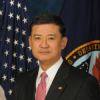Eric Shinseki

Eric Shinseki
Eric Ken Shinsekiis a retired United States Army general who served as the seventh United States Secretary of Veterans Affairs. His final U.S. Army post was as the 34th Chief of Staff of the Army. Shinseki is a veteran of two tours of combat in the Vietnam War, in which he was awarded three Bronze Stars for valor and two Purple Hearts. He was both the first Asian-American four-star generaland then the Secretary of Veterans Affairs...
NationalityAmerican
ProfessionWar Hero
Date of Birth28 November 1942
CityLihue, HI
CountryUnited States of America
What I want veterans to know is that VA is here to care for them. VA is a good system - health care wise, safety wise - highly comparable to any other system out there. Our oversight reviews tell us that. I'm very comfortable in the quality of our system.
I do engage veterans. I meet with the veterans' service organizations monthly. It's a direct, no-holds-barred discussion. I travel to their conventions, where I speak to the veterans membership. I do travel. I've been to all 50 states. When I do, I engage veterans locally. So I get direct feedback from those veterans.
No veteran should have to wait for claims. If there's anybody impatient here, I am that individual.
More importantly, if you are in a position to hire, hire a veteran. They will be the best employees you have.
An army that fought and won a war decisively finds it even more difficult to undergo change.
I spent five years working very hard to develop a relationship with the veterans' service organizations. We have together worked some major projects.
Well, let's assume the world is linear. If we required a certain amount of troops per 25,000 population in the Balkans, if the world is not radically different, something of the same extent is going to be needed in Iraq.
In the army, we do two things every day. We train our soldiers, and then we grow them into leaders, because frankly, we don't hire out. We grow our own leaders.
If you are going to make a change, make it big and bold. Walk up to the biggest guy on the block, stand in his face and get it started. Then go around, brigade by brigade, making it make sense.
I am an armor officer. I grew up as a part of the team that helped to field M-1s and M-60-A3s to the army back in 1980s. It's still a magnificent tank, and we designed it for the Cold War and Central Europe.
The magnificent army that fought in Desert Storm is a great army, and it still is a magnificent army today. But it was one we designed for the Cold War, and the Cold War has been over for ten years now.
It's important in any organization that if visions have any reality at all, it's because the organization believes that the vision is right and that they share in it. Otherwise, it becomes the good idea of one person, and that even more importantly contributes to the sense that it will not survive the departure of that individual.
I have spent a lifetime watching kids make mistakes because they were not trained or well led or properly motivated to do well. I never faulted the kids; rather, I saw opportunity to train, to motivate, to improve leadership - not to punish the individual.
It's not a battle that we would have designed. Heavy mechanized forces were coming up against light infantry, and frankly, we held our breath.